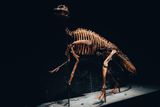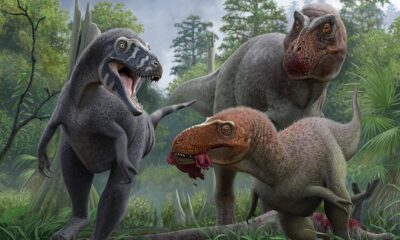Science
Dinosaur Mummies Reveal Horse-Like Hooves and Duck Bills

Researchers have uncovered extraordinary details about the Edmontosaurus annectens, a dinosaur that roamed the western United States over 66 million years ago. A new study published in Science has revealed that some of these dinosaurs were preserved as mummies, providing unique insights into their physical characteristics. Notably, these creatures featured horse-like hooves, duck bills, and miniature scales across their bodies.
The study focused on two remarkable specimens found in Wyoming, along with others located in a region identified as the “mummy zone.” These specimens, a late juvenile approximately 2 years old and an early adult aged between 5 to 8 years, were remarkably preserved under a layer of clay. Unlike typical fossil discoveries, which often consist of bones or teeth, these mummies retain outlines of soft tissues, including skin and spikes, preserved in clay.
Unusual Preservation Method
The discovery of the mummified E. annectens adds a new chapter to paleontology. The mummies were formed after the dinosaurs were engulfed by a flash flood, leading to a rapid burial. A subsequent biofilm extracted clay from the surrounding sediment, which enveloped the dinosaurs. As the organic material dissolved, a clay template of their bodies remained, measuring only 1/100th of an inch thick.
“This is a mask, a template, a clay layer so thin you could blow it away,” stated Paul Sereno, a paleontologist at the University of Chicago and senior author of the study. The preservation method provides a rare glimpse into the anatomy of these ancient creatures.
The E. annectens is one of two species of Edmontosaurus, the other being E. regalis. Both species were among the last dinosaurs to exist before the Cretaceous-Paleogene extinction event, which led to the demise of non-avian dinosaurs.
Insights into Dinosaur Characteristics
Using advanced imaging techniques such as micro-CT scans and X-ray spectroscopy, researchers were able to analyze several features of the E. annectens. The findings revealed that these dinosaurs boasted a fleshy crest along their necks, a row of spikes down their tails, and tiny scales measuring between 1 to 4 millimeters. Notably, the analysis of their hooves uncovered significant evolutionary milestones.
Researchers reconstructed the hooves based on CT scans and comparisons with other duck-billed dinosaur footprints. Each of the dinosaur’s three hind toes was encased in a wedge-shaped hoof with a flat bottom, resembling horse hooves. This discovery marks several “firsts” in paleontology, including the earliest documented hooves in land vertebrates and the first confirmed hooved reptile.
“There are so many amazing ‘firsts’ preserved in these duck-billed mummies,” Sereno noted, highlighting the significance of this discovery in understanding the evolutionary history of dinosaurs.
The ongoing analysis of the Edmontosaurus mummies is expected to yield further insights into the biology and ecology of these fascinating creatures. As more discoveries emerge from the “mummy zone,” the scientific community looks forward to understanding the dynamics of life during the late Cretaceous period.
-

 Technology5 months ago
Technology5 months agoDiscover the Top 10 Calorie Counting Apps of 2025
-

 Health3 months ago
Health3 months agoBella Hadid Shares Health Update After Treatment for Lyme Disease
-

 Health3 months ago
Health3 months agoErin Bates Shares Recovery Update Following Sepsis Complications
-

 Technology4 months ago
Technology4 months agoDiscover How to Reverse Image Search Using ChatGPT Effortlessly
-

 Technology1 month ago
Technology1 month agoDiscover 2025’s Top GPUs for Exceptional 4K Gaming Performance
-

 Technology3 months ago
Technology3 months agoElectric Moto Influencer Surronster Arrested in Tijuana
-

 Technology5 months ago
Technology5 months agoMeta Initiates $60B AI Data Center Expansion, Starting in Ohio
-

 Technology5 months ago
Technology5 months agoRecovering a Suspended TikTok Account: A Step-by-Step Guide
-

 Health5 months ago
Health5 months agoTested: Rab Firewall Mountain Jacket Survives Harsh Conditions
-

 Lifestyle5 months ago
Lifestyle5 months agoBelton Family Reunites After Daughter Survives Hill Country Floods
-

 Health3 months ago
Health3 months agoAnalysts Project Stronger Growth for Apple’s iPhone 17 Lineup
-

 Technology4 months ago
Technology4 months agoHarmonic Launches AI Chatbot App to Transform Mathematical Reasoning





















